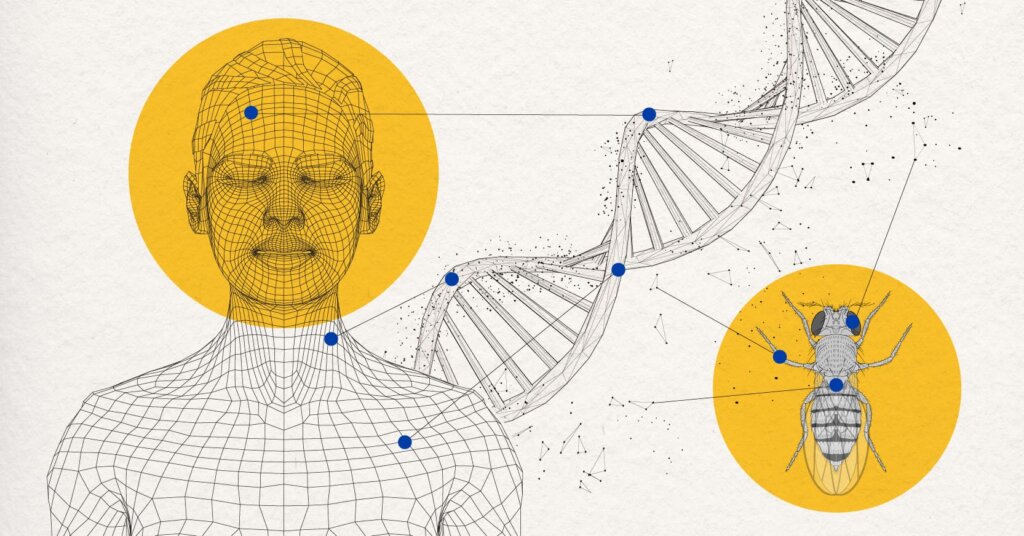Home » 4 trends changing healthcare as we know it
4 trends changing healthcare as we know it

These researchers, entrepreneurs and advocates are tackling some of the toughest issues in the health sector.
Using fruit flies as mini biomanufacturing plants to create next-generation medications. Building digital replicas of patients to speed up clinical trials of promising drug compounds. Harnessing generative AI to tailor treatments to patients. It sounds like the stuff of science fiction, but the innovations being developed in Canada and around the world could transform healthcare as we know it — not in some distant future, but within our lifetimes.
Over the past century alone, Canadian medical innovation has brought us insulin, the pacemaker and an effective Ebola vaccine. That same visionary spirit is driving the researchers, entrepreneurs, investors, policy-makers and care providers who are currently expanding the frontiers of medical possibility to improve patient outcomes and close health gaps. Here, four leading lights illuminate areas where innovation is helping to solve some of the biggest challenges in healthcare today.


Femtech to the rescue: Closing the gender gap in healthcare
Women make up more than half (50.9 per cent, to be precise) of Canada’s adult population, so you might think biotech developers would be racing to capitalize on such a significant market. The reality is that when it comes to healthcare innovation, there’s a significant gender gap. A 2023 analysis of trends in project proposals funded by the Canadian Institutes of Health Research between 2009 and 2020 found that fewer than 6 per cent of grant abstracts discussed female-specific outcomes, and fewer than 3 per cent explicitly mentioned sex and/or gender as a factor in the investigation.
This is not just a Canadian issue — it’s a universal one. And at its core, says Brittany Barreto, the problem is rooted in a lack of education. Barreto is the founder of FemHealth Insights, a consulting firm dedicated to women’s health innovation; she also hosts a podcast on this topic, completed a doctorate in molecular and human genetics at Baylor University, launched several ventures and has a section on her website dedicated to vulva stickers and 3D-printed uterus earrings — all testaments to her expertise in this field. “I’ve asked students in bioengineering master’s programs if they’re learning about the vagina and the uterus. They’re like, ‘We learn about bones, we learn about the GI system, we learn about the oral cavity, but we’re not learning about female reproductive organs.’,” she says. “I know several femtech founders who had to make their own vaginal models in their laboratories because they had no standard model to use for developing medical devices.” Those educational shortcomings extend beyond basic mechanics: One 2018 survey of American physicians conducted by the Mayo Clinic’s Centre for Women’s Health found that more than 20 per cent of respondents reported that their medical training included no lectures about menopause care. To Barreto, the implicit message is clear: women’s value is bound up in their fertility. “If you think about how innovation happens when something is valued,” she adds, “no wonder there’s never been menopause innovation.”
But, Barreto adds, things are looking up: With more women and nonbinary individuals in STEM, as well as more female founders and investors, the paradigm is shifting. She’s particularly excited about a company called Egal, which makes menstrual pads that function like toilet paper — in essence, a perforated roll that could be discreetly provided in public washrooms. It’s a simple but brilliant innovation that could significantly improve life for a large segment of the population. These shifts, Barreto says, are necessary to help tackle the gender gap in healthcare.
Learn more about the healthcare gender gap on June 13 at 10:35 a.m.


Unlocking the code of life: Generative biology can speed up the search for new treatments
If DNA is the code of life, generative biologists are science’s safe-crackers, using all the tools at their disposal to figure out the precise mechanics that will bust open the mysteries that lie within. In this case, those tools include breathtakingly powerful supercomputers, and those mysteries include, say, how amino acids (the molecules that make up proteins) work together to elicit reactions in certain cells or cause certain ailments. It sounds deceptively simple, but this could lead to cures for incurable illnesses.
One force leading the charge in this arena is Generate:Biomedicines, which was recently named one of the Top 50 Disruptors in the world by CNBC. As Geoffrey von Maltzahn explains, when he co-founded the company in 2018, he and his colleagues wanted to decode “the rules of proteins — the tiny sensors, motors, engines that make up life — and use machine learning to find patterns in the connections between DNA code and protein functions to enable the design of custom protein drugs.” The holy grail is to harness the power of generative AI to develop therapies that are precisely matched to the unique characteristics of a disease. At the moment, Generate’s system has developed two promising medications that have made it into human testing — one targets COVID, the other severe asthma. What is revolutionary about this approach is not just the sophistication of the technology, but the speed with which these treatments have evolved from a glimmer of a possibility to a viable option with the potential for commercialization. Even six years ago, von Maltzahn says, it seemed like a stretch to imagine this technology could be a true asset for biologists. “Now we believe that all future protein therapeutics will be created with the help of generative AI.”
Learn more about the role of generative biology in precision medicine on June 12 at 4:30 p.m.


Virtual proxies: Digital twins help researchers determine which medications work.
You’re not seeing double: So-called digital twins are turning up everywhere these days, from municipal disaster planning to pop stars’ album promotion. The phrase refers to AI-based platforms that use real-life data to create strikingly accurate models of a person (or a place, or a thing) with the aim of allowing experts to determine how certain variables could affect the twin’s IRL counterpart. In healthcare, this technology has a stunning range of potential applications, from the big picture — public-health officials might use digital twins to help with pandemic management, for instance — to the painstakingly specific.
Those granular details are what drive Toronto’s Altis Labs, which has developed a massive database of information based on millions of CT scans. From each scan, CEO and founder Felix Baldauf-Lenschen explains, Altis is able to assess “more than 5,000 different features,” from fat distribution and muscle mass to the full tumour burden throughout the subject’s entire body. This data is used to produce detailed virtual stand-ins, which allow medical professionals to see how a subject might respond to a battery of interventions — without ever having to poke, prod or inject their actual bodies in ways that might cause discomfort.
The boon to patients is enormous. Because the algorithm considers so many variables, Baldauf-Lenschen notes that it can be used to estimate a subject’s odds of survival far more accurately than a prediction based on tumour measurements alone. It’s also able to find the most effective treatments as efficiently as possible. By providing a means to run virtual phase 1 trials, digital twins may revolutionize research and development, which is why major pharma companies such as Bayer and AstraZeneca are working with Altis. Cancer research, says Baldauf-Lenschen, is a primary focus. “We want to help get the best treatments to market and to patients sooner and at lower cost.”
Learn more about digital twins and the future of personalized medicine on June 12 at 2:20 p.m.


Bug business: Fruit flies can mass-produce the materials to create bespoke therapeutics
Edmonton-based biotech firm Future Fields started out with a goal that improved the quality of life for sentient beings in a slightly different way: In its early days, the company was working to bring lab-grown meat and other animal-free animal products to market. Along the way, however, CSO Matt Anderson-Baron and his colleagues realized the technology that allowed them to engineer ersatz steaks could be harnessed to make proteins for a very different purpose: generating cells that serve as essential building blocks for necessary treatments, from insulin to meticulously calibrated therapeutics that are optimized for a patient’s individual physiological profile. At heart, says Anderson-Baron, “we’re trying to manufacture proteins better, faster and cheaper.”
To do so, Future Fields leverages recombinant technology — the science of isolating snippets of DNA and using a host cell to replicate the desired genetic material, which has been in use for more than half a century. But unlike conventional approaches, which typically rely on cultivating yeast or mammalian cells in massive steel bioreactor tanks, the company has lit on a novel (and easily scalable) vessel to produce its proteins en masse: the common fruit fly. There are many advantages to using fruit flies as mini factories, Anderson-Baron explains. They’re cost-effective, have high reproductive rates and require significantly less infrastructure than a traditional bioreactor. Best of all, because insects have multicellular systems, “we have many, many different cell types — at least 200 — each with their own protein production machinery that we can harness.”
Anderson-Baron emphasizes that Future Fields has no intention of becoming a drug developer or producer on its own. The company’s aim is to generate the essential building blocks — active pharmaceutical ingredients, or APIs — for partners who want to bring necessary medications to market. “Often what we see is that APIs are needed to develop a new therapy. Typically, you might be targeting a particular protein — if you can’t get access to that, it derails that process.” This technology is especially useful in the creation of personalized therapeutics and treatments for rare conditions, which can be cost-prohibitive because the target market is so tiny. Last year, Future Fields teamed up with Montreal-based Jenthera, with the aim of scaling production of the latter company’s CRISPR-engineered proprietary cancer-fighting protein for clinical exploration. It’s an example of the tremendous potential contained in this teeny-tiny tech. As Anderson-Baron notes, “We want to enable this funnel of therapies that’s being hindered at the moment because of technical constraints.”
Learn more about the huge potential of tiny bioreactors on June 12 at 2 p.m.
Sarah Liss writes about technology for MaRS. Torstar, the parent company of the Toronto Star, has partnered with MaRS to highlight innovation in Canadian companies.
To find out more about innovation and the future of medicine, check out MaRS Impact Health, which runs June 12 and 13 at the MaRS Centre.
CREDIT: Photo illustration: Stephen Gregory, Images: Adobe Stock
MaRS Discovery District
https://www.marsdd.com/
MaRS is the world's largest urban innovation hub in Toronto that supports startups in the health, cleantech, fintech, and enterprise sectors. When MaRS opened in 2005 this concept of urban innovation was an untested theory. Today, it’s reshaping cities around the world. MaRS has been at the forefront of a wave of change that extends from Melbourne to Amsterdam and runs through San Francisco, London, Medellín, Los Angeles, Paris and New York. These global cities are now striving to create what we have in Toronto: a dense innovation district that co-locates universities, startups, corporates and investors. In this increasingly competitive landscape, scale matters more than ever – the best talent is attracted to the brightest innovation hotspots.


